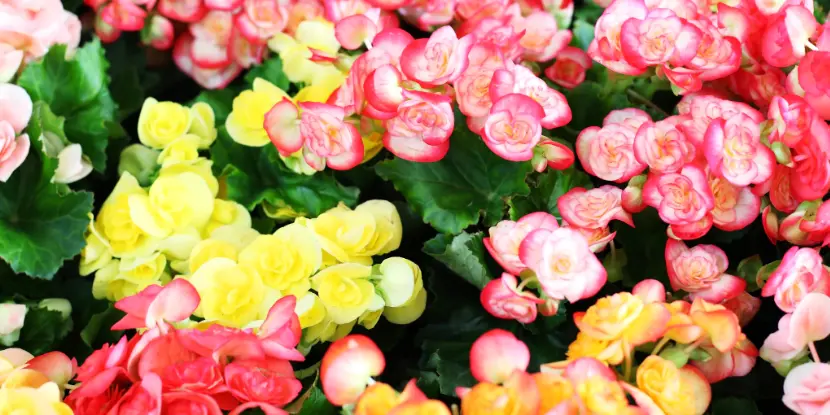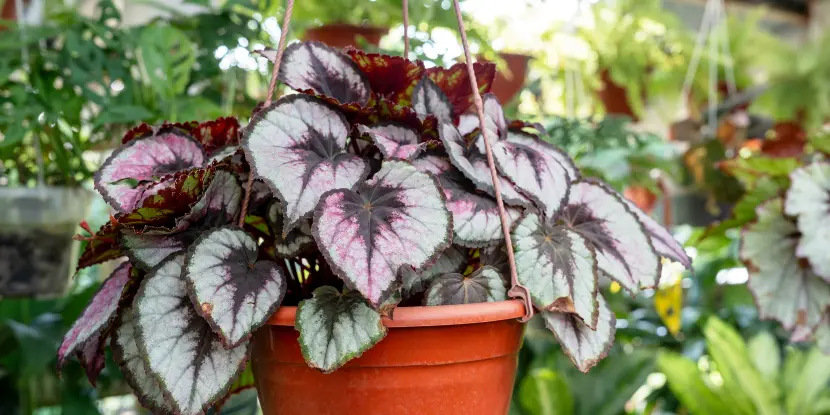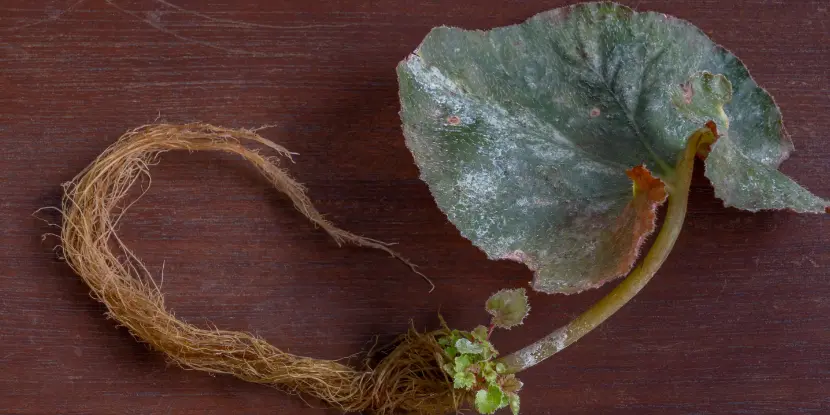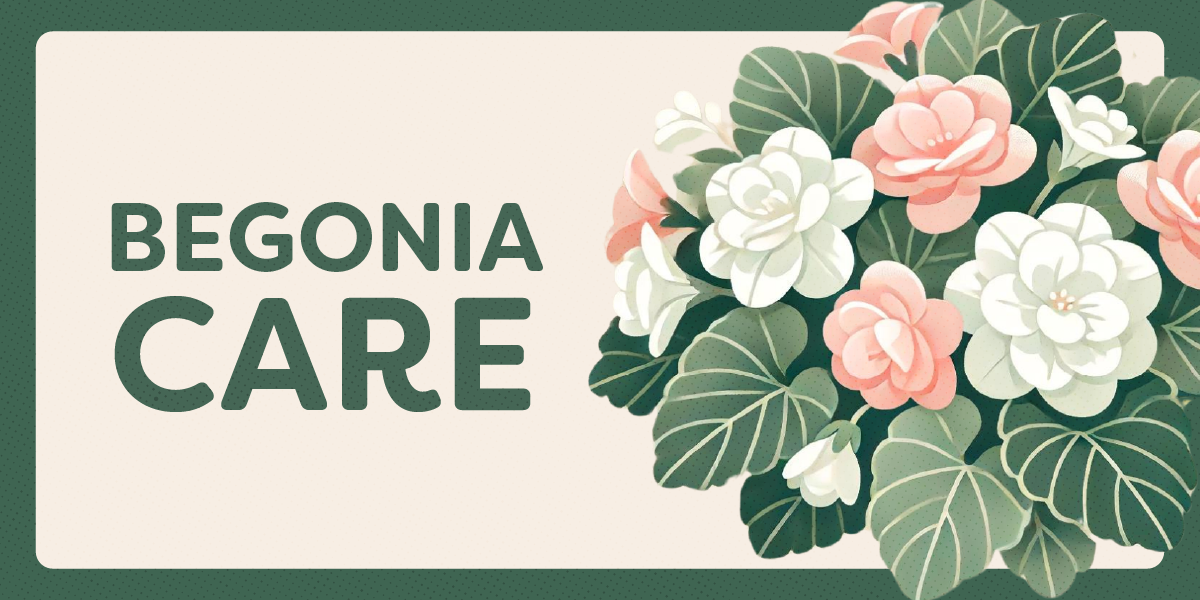Begonias are native to tropical and subtropical regions worldwide, with a significant concentration in Central and South America.
Discovered in the humid forests of Brazil and Mexico, these plants have been cultivated and hybridized to produce the diverse varieties we see today.
The genus Begonia was named after Michel Bégon, a French patron of botany, by the botanist Charles Plumier, who first recorded its existence in the late 17th century.
Begonias are popular with gardeners and indoor plant enthusiasts alike, thanks to their brilliant blooms, varied foliage, and relatively easy maintenance.

The spotted leaves of a Begonia Maculata.
Begonia Varieties
The American Begonia Society recognizes over 1,800 different begonia species. New cultivars appear every year.
The most popular types include:
- Tuberous Begonias: These are the best-known begonias. They’re often planted as annuals in gardens and produce large, rose-like flowers in a range of colors. They can grow up to 2 feet.
- Rex Begonias: Also known as fancy-leaved begonias, these plants feature striking patterned leaves in shades of silver, green, pink, and purple. They usually don’t bear flowers; foliage is the main attraction.
- Cane Begonias: These are tall, upright-growing begonias with thick stems that resemble bamboo canes. They bear clusters of fragrant, pendulous flowers in red, pink, or white shades.
- Rhizomatous Begonias: This group includes popular varieties like the “Iron Cross” and “Tiger Paw” begonias. They have thick rhizomes (underground stems) and produce small to medium-sized leaves with captivating patterns and textures.
- Shrub-like Begonias: As the name suggests, these begonias have a bushy growth habit and can reach up to 6 feet. They’re prized for their large, glossy leaves and gaudy blooms in shades of pink, red, orange, or white.

Spring scene of hot pink begonia flowers in the garden.
Growing Conditions
Light
Most begonias prefer bright, indirect sunlight. Too much direct sunlight can scorch their leaves, while too little light leads to leggy growth and fewer blooms.
An east or west-facing window is usually best. Outdoor begonias should have partial shade.
Soil & Potting
Begonias need well-draining soil that retains some moisture. An ideal potting mix will have added perlite or sand to improve drainage. If planting in the ground, ensure the soil is rich in organic matter and drains well.

Pinwheel Begonia “escargot” in a pot.
Temperature & Humidity
- Begonias are native to tropical and subtropical regions.
- They flourish in warm, humid environments with temperatures between 60-75°F (15-24°C).
- In cooler climates, begonias should be protected from frost and cold drafts.
- Maintaining high humidity can be challenging indoors, but a humidity tray or a room humidifier can help.
Watering Practices
- Overwatering can cause rot. Underwatering can stress the plant and inhibit blooming.
- Water when the top inch of soil feels dry. Depending on the climate and growing conditions, this might mean watering every few days or once a week.
- Water the soil directly rather than the leaves. Damp foliage can encourage fungal diseases. Make sure excess water drains away.

Red, pink, and yellow begonias in bloom.
Fertilizing
- Use a balanced, water-soluble fertilizer with an equal ratio of nitrogen, phosphorus, and potassium (e.g., 10-10-10) or a fertilizer formulated for flowering plants.
- Always dilute the fertilizer to half the recommended strength to avoid burning the roots. This is particularly important for begonias, which are sensitive to over-fertilization.
- Fertilize begonias every 2-4 weeks during the growing season from spring to early autumn. During the dormant period in winter, reduce fertilization to once a month or stop it entirely.
- Make sure the soil is moist before applying fertilizer. Water the begonias thoroughly a day before feeding them to prevent the roots from being shocked by the sudden influx of nutrients.
- Apply the diluted fertilizer evenly around the base of the plant, avoiding direct contact with the leaves and stems.
Pruning & Maintenance
- Pinching: For bushier growth, pinch back the tips of young plants. This encourages the plant to produce more side shoots for a fuller appearance.
- Deadheading: Remove spent flowers regularly to stimulate more blooms and prevent the plant from putting energy into seed production.
- Removing Damaged Leaves: Remove any yellowing or damaged leaves to keep the plant looking its best and to prevent disease.
Common Pests & Problems
- Aphids and Spider Mites: Manage these tiny pests with insecticidal soap or neem oil. Regularly inspect plants and treat them at the first sign of infestation.
- Powdery Mildew: This fungal disease appears as a white, powdery coating on the leaves. To prevent it, ensure good air circulation and avoid overhead watering.
- Root Rot: A serious problem caused by overwatering. Ensure the soil is well-draining, and never let begonias sit in water.

Painted-leaf begonia begonia rex prince pink in a hanging pot.
Seasonal Care
Spring & Summer
These are the growing seasons for most begonias. Increase watering frequency as temperatures rise, and consider moving outdoor begonias to a shaded spot if the summer sun becomes too intense.
Fall & Winter
As temperatures drop, begonias will enter a dormant or semi-dormant state. Reduce watering and stop fertilizing to let the plant rest. If your begonias are outdoors, bring them inside before the first frost. For tuberous begonias, you may need to dig up the tubers and store them in a cool, dry place until spring.
Propagation
Depending on the type, you can propagate begonias through leaf cuttings, stem cuttings, or division. Here’s a quick guide:
- Stem Cuttings: Cut a healthy stem just below a node, remove the lower leaves, and place it in water or moist soil until roots develop.
- Leaf Cuttings: Cut a healthy leaf and place it on moist soil. In a few weeks, new plantlets should form from the cut edges.
- Division: For rhizomatous or tuberous varieties, divide the root mass or tuber during the dormant season and replant the divisions.

Root growth on a begonia leaf.
FAQs: Growing Begonias
Q: How often should I repot my begonias?
Generally, every 1–2 years, depending on the begonia’s growth rate and the size of the pot. If the plant becomes root-bound (roots growing out of the drainage holes), it’s time to move it to a larger pot. The best time to repot begonias is in spring, just before the active growing season.
Q: Can begonias grow indoors year-round?
Many types of begonias thrive indoors year-round with the right conditions. Place them in bright, indirect sunlight, maintain indoor temperatures between 60-75°F (15-24°C), and keep humidity levels high. During winter, protect begonias from cold drafts and dry air from heating systems.
Q: Can I grow begonias in containers?
Begonias are excellent candidates for container gardening. Choose a container with good drainage, and use a well-draining potting mix enriched with organic matter. Ensure the container is large enough to accommodate the plant’s root growth.
Q: How often should I water container-grown begonias?
Water your container-grown begonias when the top inch of soil feels dry. Depending on your climate and the size of your container, this might be every few days.
Q: What kind of pot is best for begonias?
Terracotta pots are ideal because they allow for better airflow to the roots, reducing the risk of overwatering. The pot should have drainage holes to prevent water from accumulating at the bottom.
Q: Can I grow begonias from seeds?
Yes, but it requires patience as they germinate slowly. Sow seeds on the surface of a moist, well-drained seed-starting mix and keep them in a warm, brightly lit area. Germination can take several weeks.
Q: Do begonias need to be staked?
Not all begonias need staking, but taller varieties or those with heavy blooms may benefit from support to keep them upright. Secure the stems with bamboo stakes or plant supports.
Q: What is the best way to increase humidity for indoor begonias?
You can increase humidity around indoor begonias by placing a humidifier nearby, grouping plants, or setting the pot on a tray filled with pebbles and water. Elevate the pot above the water level to prevent root rot.
Q: How can I tell if my begonias are getting too much sun?
Leaf scorch, faded or crispy leaves, and reduced blooming are signs that your begonias are getting too much sun. Move the plant to a spot with filtered light or provide shade during the hottest part of the day.
Q: What should I do if my begonia’s leaves turn yellow?
Yellowing leaves can indicate overwatering, insufficient light, or nutrient deficiencies. Check your watering practices first and ensure the plant gets the right indirect light. If those conditions are optimal, apply a balanced, diluted fertilizer.

